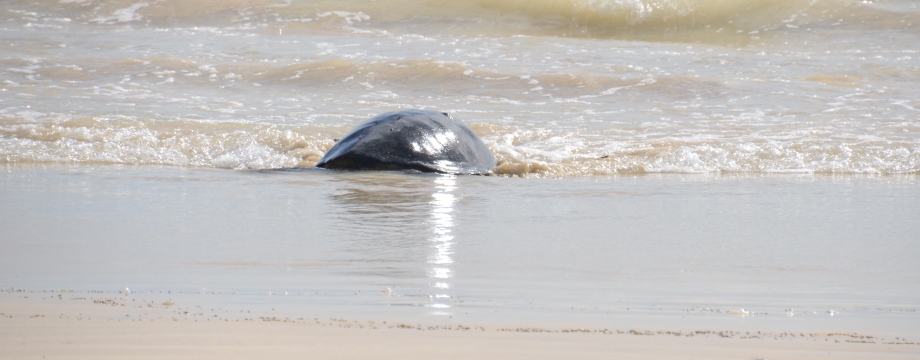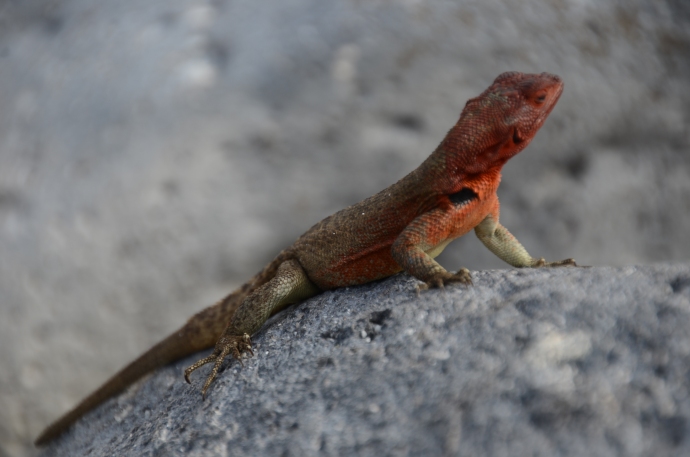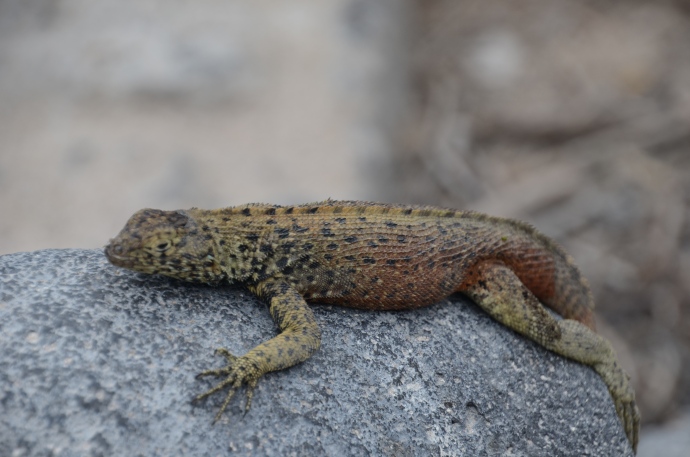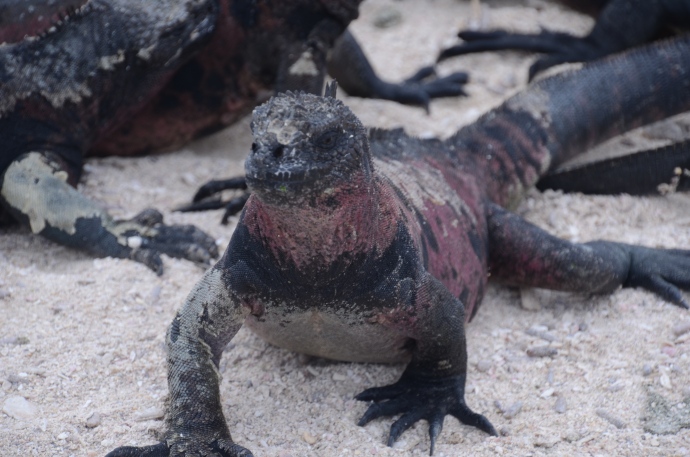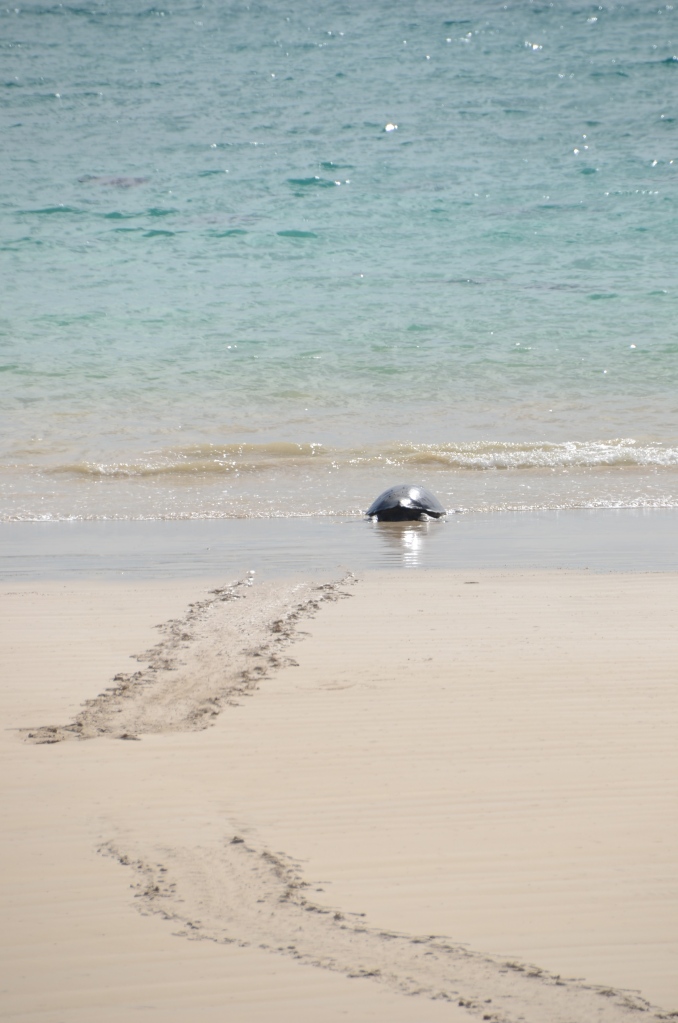No blog about the Galápagos would be complete without a discussion of the archipelago’s reptiles. After all, the most famous residents of the chain are the giant reptiles that bear the island’s name — the Galápagos Giant Tortoise, the world’s largest tortoise and the thirteenth heaviest reptile, weighing in at over 800 pounds. So it is fitting we begin our review with Pepe.
Pepe is about 135 years old and lives at the Interpretative Center on San Cristóbal. His life consists of grazing, sunbathing and napping about 16 hours each day. Galápagos Giant Tortoises are the longest-lived of all vertebrates. As the world’s largest tortoise species, some of Pepe’s relatives can exceed 5 feet (1.5 meters) in length.
We did not go into the highlands to see wild tortoises; our ship had just come from Isabella Island, home of the greatest population of giant tortoises, and wouldn’t return until the next load of tourists were on board. Only about 15,000 giant tortoises remain in the world and they are listed as endangered. Introduction of non-native species threatens food supply. Goats, for example, have been removed from some islands because they ate the grasses down to the roots, obliterating the main food supply of the vegetarian tortoises who are unable to eat the close-cropped plants.
Lava Lizards
Lava lizards scurry across volcanic rocks that line the seashore. Males are larger than females. The females are distinguishable with bright red skin under their throats and the males are often seen doing “push-ups” as trying to protect their territories from other males. Many lava lizards inhabit the same rocky precipices as the marine iguana.
Marine Iguanas
Dividing their time between land and sea, marine iguanas are endemic to the Galápagos. As the world’s only sea-going iguana, they have evolved a nasal gland to excrete the excess salt they take in from the sea water. Think short sea spray snorts. After searching and swimming in the cold sea for food, they lay on the black rocks along the seashore, absorbing the equatorial sunshine.

A male marine iguana (top) defends his harem (most of the other lizards) from interloping males seeking amorous encounters

Ok, we find this one to be very cool. When we look at it on the big computer monitor, we can see that this marine iguana has just expelled the sea water from his nose. The water is radiating away from the lizard’s head.

“There’s been a multi-lizard pile up on route 80.” Or maybe one lizard had the football and the defensive line really stopped him. No, really, it’s nearing the end of the day and the lizards are gathering together to preserve their warmth. Not as exciting an answer as the first two, eh?
Pacific Galápagos Green Sea Turtles
Pacific Galápagos Green Sea Turtles can live for 100 years. Six or seven times during their lifetime, female Galápagos green turtles take two to three hours and lay 50-80 eggs. Wide tracks in the sand show their path to the nest, beyond the tide mark, near to where the island side of the beach ends and the grasses begin.
Sixty days later, the eggs will hatch at night and the little turtles will rush en masse to the sea. This night journey protects them from most aerial predator assaults. Mammals and other reptiles also prey on the young soft shells. Living in the sea, sharks and human hunters are the only real threat.

The exhausted Galapagos green sea turtle (on the right) rests before returning to see. The green Galapagos she turtle fan on the left isn’t nearly so tired. This particular human isn’t a threat to the hatchlings.
January was “turtle time” and the copulating turtles looked like floating rock piles in the sea. The process has the female doing most of the work. Generally during courtship, she will mate with at least five different suitors. The act itself isn’t a piece of cake. She must support the full weight of the male on her shell and remain close to the surface so that she can still breathe as the male tries to push her underwater. The process is surprisingly noisy — the clack-clack of the shells hitting each other sounds like whacking two clay pots together. Multiply that sound by a bunch of frisky turtles in the same area and it can be very loud.
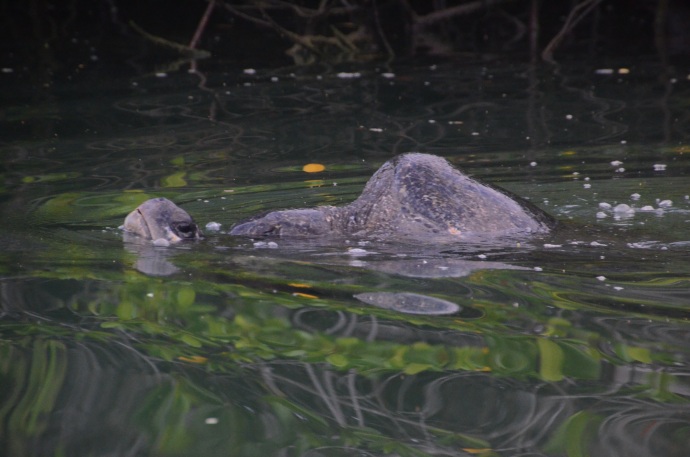
Here the aggressive male is on top, while the female sea turtle pokes her head through the surface for air
Land Iguana
Another well-known reptilian resident, the Land Iguana, is quite large. It averages 48 inches in length and up to 25 pounds in weight. It can live for sixty years. Mostly vegetarian, these iguanas prefer the prickly pear cactus which provides 80% of their dietary moisture. During the rainy season, iguanas get moisture from standing pools of water and the yummy yellow Portulaca flowers.
Land iguanas also act as a mesa for some birds. The birds remove parasites and ticks from the iguanas, feeding themselves and making the iguanas more comfortable. Several years ago, Two Who Trek saw a larger scale symbiotic example with ox pecker birds and cape buffaloes in South Africa.
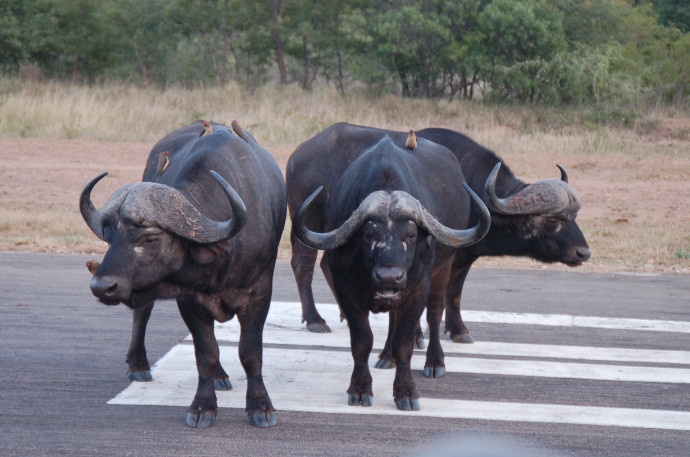
Cape buffalo with oxpecker birds picking insects and nasty stuff off the buffalo. These animals were on a game reserve airport runway in South Africa — definitely not in the Galapagos.
We saw our first land iguana on the last day of the cruise. He was lounging next to a building when the San José dinghy dropped us on Santa Cruz Island. We watched him while waiting for the bus to take us to the airport for the ride back to the mainland.

The only land lizard we saw, and that was from the bus taking us to the airport on Santa Cruz island
Amphibians
Did we see any amphibians? No, but we don’t feel slighted. We spent time enjoying the uniqueness of this place and feel grateful and blessed that we had the opportunity to visit. There are also no native amphibians in the archipelago. The theory is that many of the reptiles that live on the islands were carried there from the mainland, on rafts of vegetation. Reptiles can tolerate the harsh salty seas and strong sun rays associated with weeks at sea. No amphibians and few mammals could have made the thousand mile trip on a raft.
